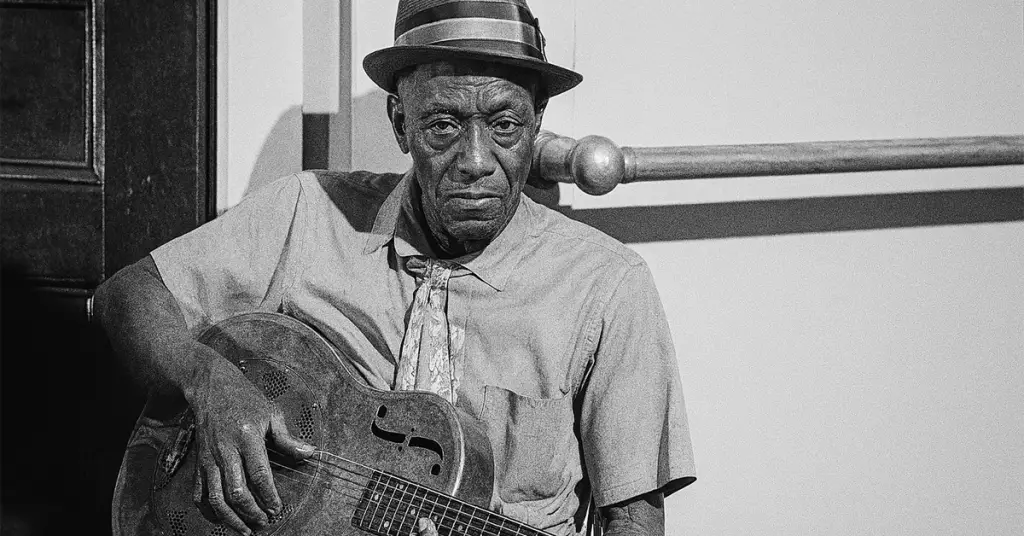The Voice That Shook the Devil: How Son House Dragged My Soul to the Delta
I’d been listening to blues for years—Skip James, Robert Johnson, even Muddy and Wolf. But then I heard Son House for the first time, and nothing was the same after that.
It was “Death Letter.” That slide guitar hit like thunder, raw and jagged, and then came that voice—boiling with rage and sorrow, rasping out from deep inside the earth. I sat there, frozen, goosebumps on my arms. This wasn’t just blues. This was a man ripping open his chest and letting you stare at his soul.
The Preacher Turned Blues Prophet
Born Eddie James “Son” House Jr. in 1902 (some say 1901 or ’03) in Riverton, Mississippi, he came up steeped in gospel and moral fire. He was a preacher first—before ever touching a guitar. That preacher’s intensity never left his voice.
He didn’t even start playing guitar until he was around 25, and when he did? He didn’t learn to play—he attacked it. His slide style was all emotion and power, played on a worn-out National resonator like he was trying to save or destroy the world—maybe both.
He recorded a handful of songs for Paramount in 1930 that barely made a ripple at the time… and then, decades later, Son House was rediscovered during the 1960s folk revival, brought out of obscurity, and given the chance to show the world what real Delta blues sounded like from the source.
The Sound: Grit, Gospel, and Fire
Son House didn’t just play the blues—he preached it. His slide guitar was furious, all steel and slide and stomp. He didn’t care about finesse. He cared about feeling. You could hear the strings buzz and break, and it made it more real.
His singing? A howl, a prayer, and a threat all at once. You felt the gospel roots, the sin, the regret. It wasn’t pretty. It was raw truth.
And when he performed, he poured his whole body into it. Slapping the guitar. Rocking back and forth. Eyes shut tight. You couldn’t look away.
The Songs That Set My Hair on Fire
There aren’t hundreds of tracks, but every one is a masterclass in blues as emotional exorcism. These are the ones that turned me into a believer:
- 🎸 “Death Letter” – The definitive Son House track. A one-man band of grief and fury.
- 💔 “Grinnin’ In Your Face” – Just his voice and handclaps. A chilling sermon about false friends.
- 🕯️ “John the Revelator” – A haunting, apocalyptic spiritual like no other.
- ⚡ “Preachin’ Blues” – Rage, rhythm, and a broken preacher’s soul.
- 🔥 “Levee Camp Moan” – Long, slow, hypnotic. It’ll grab your spine and not let go.
And don’t miss the 1930s recordings like “My Black Mama” and “Clarksdale Moan”. Dusty, crackly, unforgettable.
Seeing the Fire in His Eyes
I never saw Son House in person—he passed in 1988—but I’ve watched every clip, especially those filmed after his rediscovery in the ’60s. There’s one video of him doing “Death Letter” where he’s sweating, rocking, eyes wide like he’s staring into the void, and the guitar is just screaming. It’s raw electricity.
Even in his 60s and 70s, with arthritic fingers and a lifetime of hard miles, Son could still shake a room to its foundation.
Why Son House Still Wails Through the Ages
You don’t get the blues without Son House. You don’t get the anger and redemption, the gospel fire, the slide that sings and screams.
He was the link between the church and the juke joint, between salvation and sin. Between Robert Johnson (who learned from him) and every bluesman who ever plugged in a slide afterward.
Son House didn’t play the blues to entertain. He played to survive. To warn. To testify. And the scars in his songs are as real now as they were in 1930.

Where to Start If You’re New
Welcome to the deep end:
- 🎧 The Legendary Son House: Father of Folk Blues (1965) – A perfect intro from his rediscovery period. Includes “Death Letter,” “John the Revelator,” and more.
- 💿 Delta Blues (early Paramount sides, 1930) – Grainy, historic, and vital.
- 🎥 YouTube: Search “Son House Death Letter live” or “Son House Grinnin’ in Your Face” to see raw emotion with no filter.
More at Mississippi Blues Trail
Son House didn’t play music. He played truth. He didn’t sing songs. He sang warnings. For me, he’s not just a blues legend—he’s the voice that lives in the dirt of the Delta, in the cracks of a worn guitar, in the fire behind every real bluesman since. And when I need to remember what the blues really is… I go back to Son House. Every. Time.


Facebook Comments